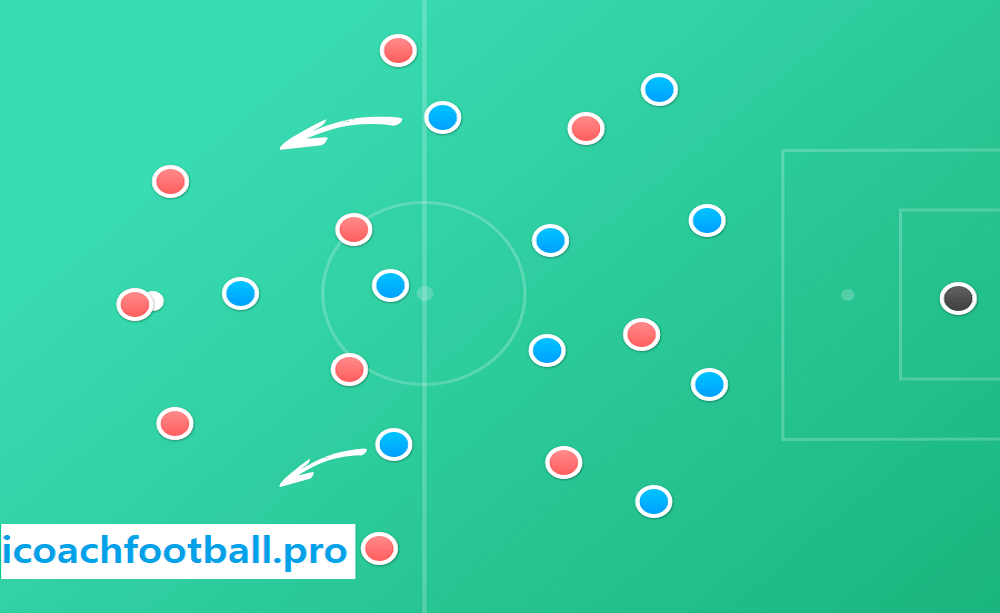The 4-2-3-1 formation is a good and popular tactical setup used by many top coaches and football teams around the world. It is known for its versatility and ability to control the game in both attack and defense. In this article, we will discuss the strengths and weaknesses of the 4-2-3-1 formation.
The 4-2-3-1 is a very common formation in modern football because it has many advantages. Teams that use this playing system seek flexibility above all without neglecting defensive stability, which is sometimes jeopardized by a 3-5-2 formation (when poorly applied).
A widely used formation today, the 4-2-3-1 has real advantages: tactical flexibility, defensive stability, etc. But, is 4-2-3-1 a good formation ? How to work on it and what exercises to implement?
What is 4-2-3-1 formation in football? [Explained]
The 4-2-3-1 is a playing system which consists of 4 defenders, 2 defensive midfielders, 2 attacking midfielders on the wings , a central attacking midfielder as well as a striker.
The 4-2-3-1 formation is broken down into 4 distinct lines , with 2 wingers who will move back into midfield in the defensive phase.
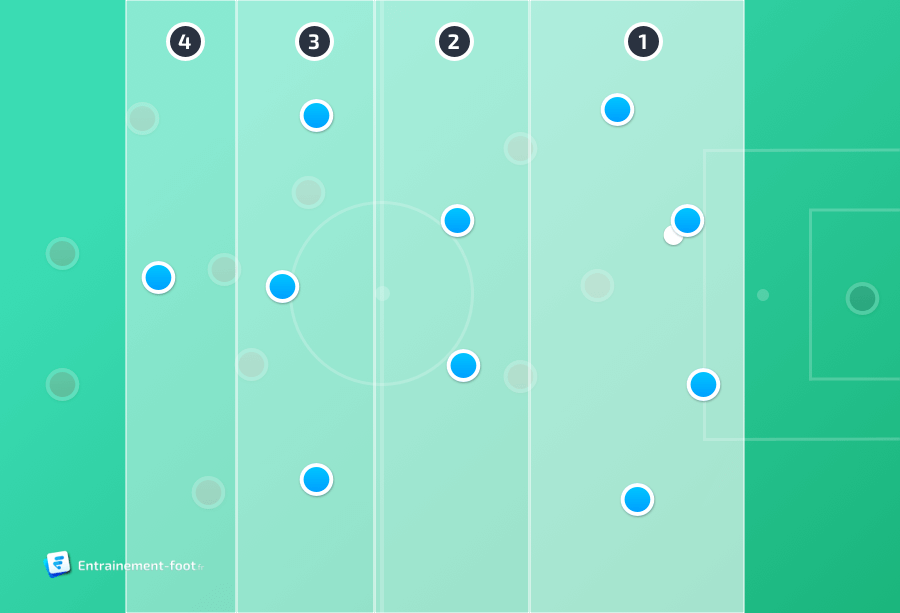
The different lines of 4-2-3-1
But then how to play well in 4-2-3-1? What are the defensive instructions to follow and what offensive animation should be proposed? The 4-2-3-1 has many advantages but also some disadvantages to avoid. A quick overview with the Football Training team .
Tactics: how to play in 4-2-3-1?
Defensively, it is important to remember that you are going to apply a middle (or low) block. You will have very good defensive stability thanks to your 4 defenders and 2 defensive midfielders.
At the level of your offensive line, there will then be 2 scenarios when it comes to applying pressure:
- Applying pressure against a 4-man defense
- Applying pressure against a 3-man defense
Against a 4-man defense, if the opposing left side is in possession of the ball, your right winger will then press the latter. The forward attacker will come and block the central defender closest to the ball , while the left winger will press the 2nd central defender. This will leave the 2nd opposing side free, furthest from the ball.
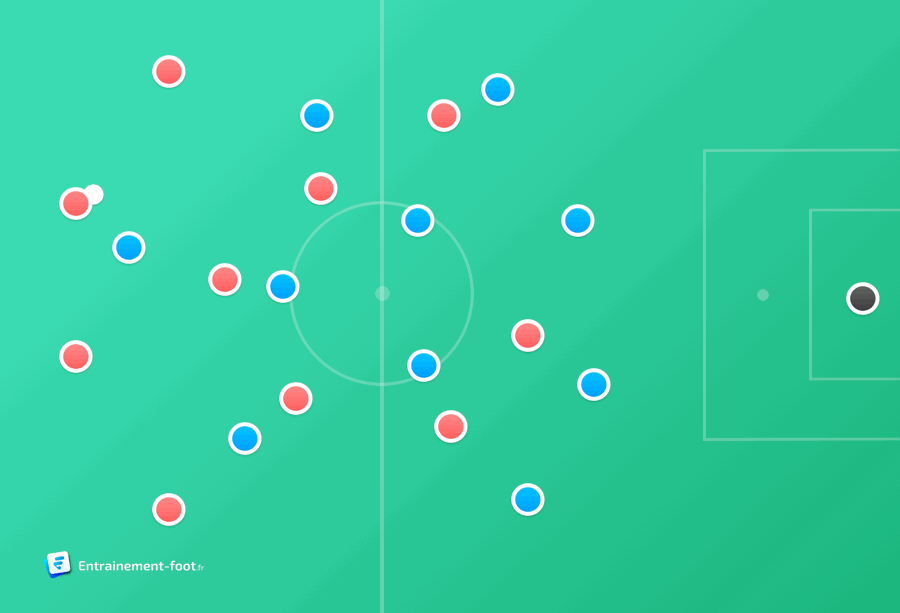
4-2-3-1 against a 4-man defense
Against a 3-man defense, your center forward positions himself at the level of the central central defender while the wingers will block the passing lines between the other 2 central defenders and the opposing full-backs.
Your full-backs will then move up a notch (slightly) to block the spaces behind the opposing full-backs. If the central central defender plays on one of the other two central defenders, it is your attacking midfielder who comes to press, temporarily transforming the formation into a flat 4-4-2.
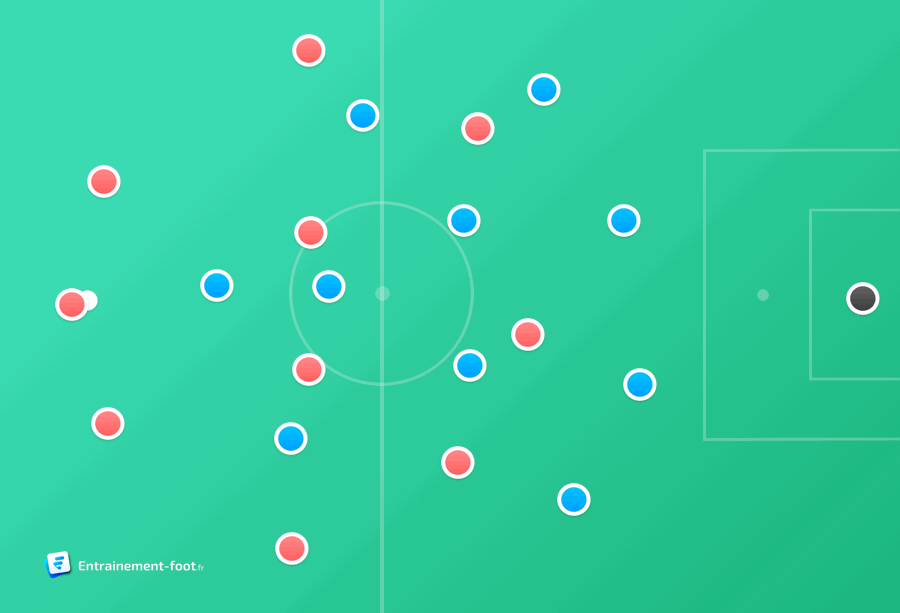
4-2-3-1 against a 3-man defense
The offensive animation of 4-2-3-1
The construction of the game is mainly focused around the 2 central defensive midfielders . Like Toni Kroos at Real Madrid, the latter will be very active from the start of the action. The left and right attacking midfielders will then move up a notch so that the central midfielders can build the play. When they lose the ball (or if the opposing team offers a high block), they will go down a notch to create a 4-4-2 .
The strengths of the 4-2-3-1 formation
The strong points of a 4-2-3-1 playing system are tactical flexibility , the possibility of playing possession or against (depending on the opponent) and its great defensive stability due to the presence of a defense of 4 and 2 defensive midfielders.
One of the main strengths of the 4-2-3-1 formation is its ability to provide a solid defensive structure. With two holding midfielders in front of the backline, the team has a strong presence in the central areas of the pitch, making it difficult for the opposition to penetrate through the middle.
Another strength of the 4-2-3-1 formation is its attacking potential. The three attacking midfielders, often referred to as the “number 10” and the two wingers, provide a lot of creativity and goal-scoring opportunities. This formation allows for quick transitions from defense to attack, as well as effective pressing and counter-attacking.
Unlike a 4-3-3 system , the 4-2-3-1 formation avoids certain defensive imbalances. Central defensive midfielders can fill certain gaps in the wingers.
Weak points of the 4-2-3-1 pattern
While the 4-2-3-1 formation has its strengths, it also has some weaknesses that need to be considered. One of the main weaknesses is the potential lack of width in attack. With only two wingers, the team may struggle to stretch the opposition’s defense and create space on the flanks.
Another weakness of the 4-2-3-1 formation is the reliance on the lone striker. If the striker is not in good form or gets injured, the team may struggle to score goals. It is important to have a strong and reliable striker who can hold up the ball and bring the attacking midfielders into play.
The main disadvantage of this playing system is the spaces left between the full-backs and the wingers . This can create a break between the 6 defensive players and the 4 offensive players and you will then truly have 2 distinct teams.
This distinction can then make your team’s offensive play very stereotypical . Without the contribution of the full-backs or the support of a defensive midfielder, the 4 offensive players will very quickly find themselves alone. Also remember to take care of your striker , who will have to make a lot of effort during the pressing phases.
What training exercises to work on the 4-2-3-1 formation?
The first exercise that we offer you is high pressing work and rapid attacks on 2 small goals . This is a very good exercise offered at Tottenham, ideal to end a session on a reduced game.
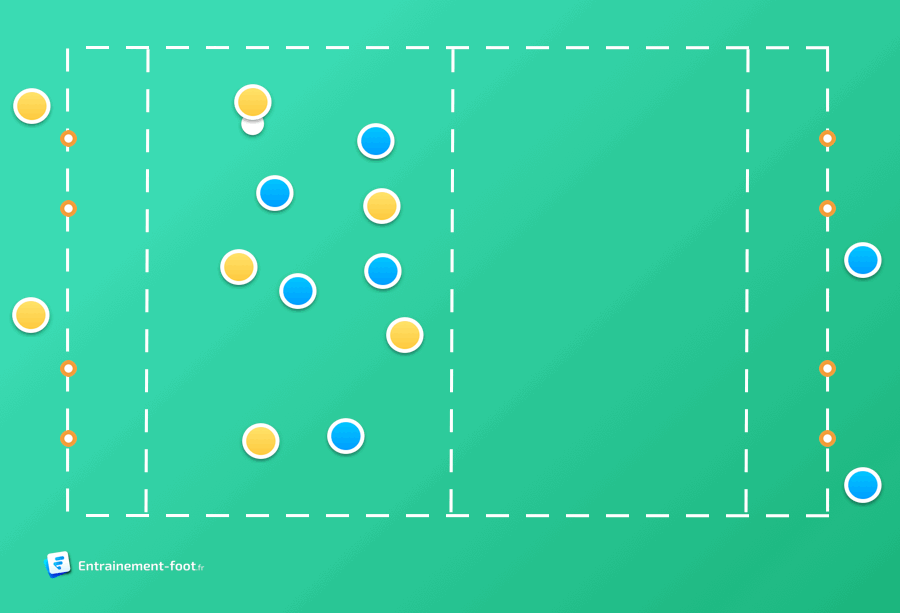
High pressing and quick attacks on 2 small goals
Define a space approximately 30x40m then divide it into 2 areas of equal surface area. Then mark out 2 zones of 5m wide at each end of the main zone. Finally place 2 small goals on each of the exterior lines (see animation above). Form 2 teams of 7 players , including 2 players from each team in the secondary zones.
The exercise will start with a 5vs5 possession game in one of the main zones. The offensive team (here in yellow) aims to make a minimum of 5 passes before playing on one of the 2 supporting players, who must pass it back with one touch so that a player of the team can then score on one of the small goals.
The defending team (here the blues) must quickly look for one of the supporting players on the other side of the field as soon as the ball is recovered. Once the pass is made, all players switch to the other zone and a new possession begins.
The second exercise that we offer you to work on the 4-2-3-1 during your next training session is an attack-defense transition exercise with a 5vs3 on a double zone .
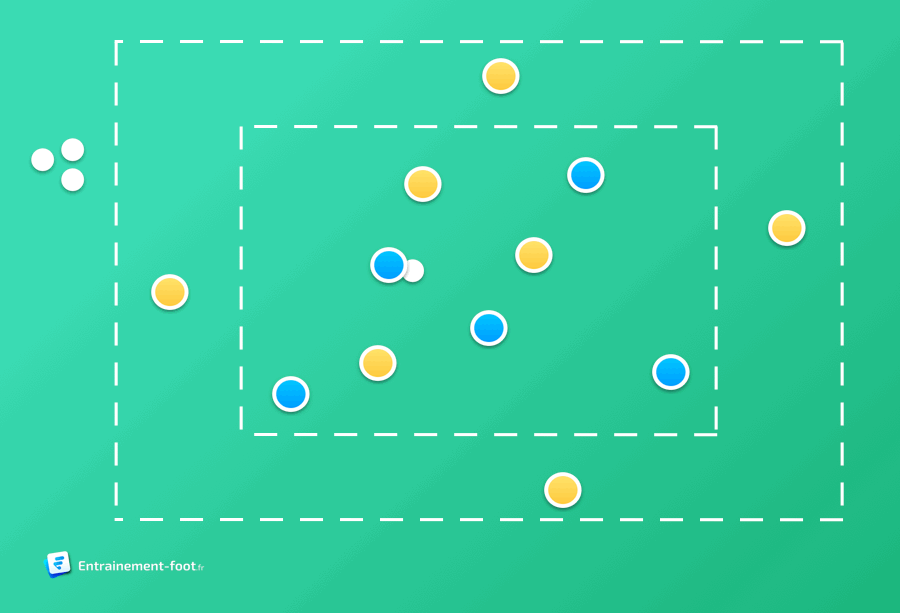
Attack-defense transition with a 5vs3 in a double zone
Do not hesitate to consult the exercise sheet for more details.
The 4-2-3-1 Against Different Systems
This chapter focuses on how the 4-2-3-1 system can be used to defend against the other most popular systems: 4-4-2, 4-3-, 4-5-1, 3-5-2 and also against another team playing a 4-2-3-1.
4-2-3-1 against a 4-4-2
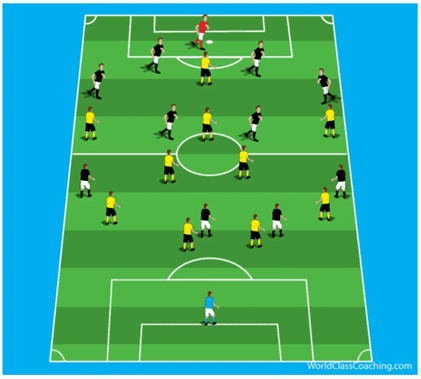
4-2-3-1 defence is in Yellow.
The basic set up for the 4-2-3-1 against a 4-4-2 would be to play the wide attackers 1v1 against the full backs. The attacking midfielder to play between the central midfielders and move across to one side as the ball moves there. With the 2 central midfielders close enough to press and cover as the ball is moved wide.
The key areas against a 4-4-2 are the central midfield area and the central defensive area – the midfield have a 3v2 initially but a striker who drops into midfield may create a 3v3 and the near side central midfielder may have to drop off or screen the front of the striker to block passes into him. Players should be spread out initially as when play is passed wide, players can move across and play to a shape and a way of pressing/covering/balancing the defence.
4-2-3-1against a 4-3-3
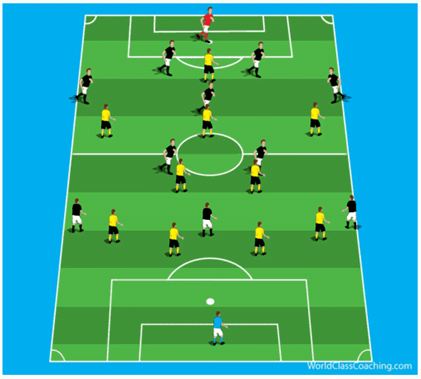
Against a 4-3-3, you can almost play a man-man marking system all over the field. With both teams having 1 centre back spare from having a direct opponent at all times. This is particularly useful if you are playing against a team with slow players.
The wide midfielders could pick up the runs of the full backs. Or leave them alone and attack into the space in transition. Giving the full back a problem of when and how often to attack. The attacking midfielder can mark or screen the defensive midfielder at the bottom of the triangle. Making it difficult for him to influence the game in attack. While the two central midfielders can play 1v1 against their opposition central midfielders.
The 2 full backs can play 1v1 against the wingers.
4-2-3-1 against a 4-5-1
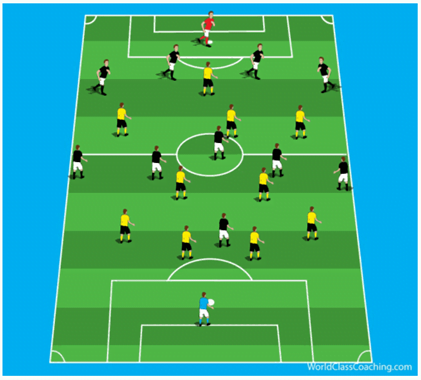
When playing against a flat 4-5-1 formation, the 4-2-3-1 is outnumbered across the central line 5v2. But as it has players ahead of and behind this line, so it means that they can screen the front when defending. But also pressure from behind quickly. As the opposition have 1 striker, the 2 full backs may be able to push up into midfield, making a 4 and leaving a 2v1 in the last line of defence. Where only quick intricate passing through midfield.
If the full backs do push up into midfield, they would have a 7v5 overload. Including the players pressing in front.
Against a 3-5-2, the 4-2-3-1 has many problems inside the oppositions half. The front 4 need to position themselves to allow themselves short enough distances to quickly cover passing lanes forward. And allow the defence time to move forward into a position which makes the field smaller and easier to defend.
4-2-3-1 against a 4-2-3-1
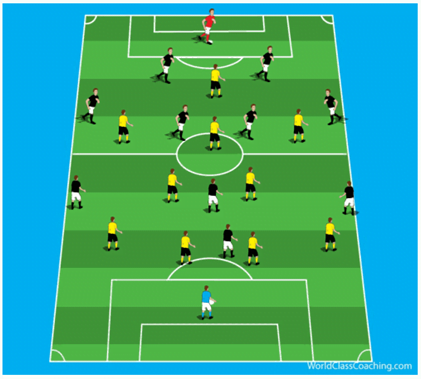
The 4-2-3-1 against a 4-2-3-1 is not like a 4-4-2 against a 4-4-2 . There is space between the winger and full back meaning that to play directly against each other. Leaving space behind in the corner of the defence. Or the winger needs to play high against a deep full back. Meaning that there is space for his own attacking full back to come forward.
In the centre, 2 central midfielders play 2v1 against the attacking midfielder, although with the flexibility of this formation. Possibly one of the central players will venture forward to help the attack. In a 4-4-2 v 4-4-2 battle, the central midfielders and wingers play 1v1. If they attack, play against the opposition full backs, which can make it easy to play predictably.
The 4-2- 3-1 offers less possibilities of cancelling out your own attacking game against any other formation. Only a 4-3-3 comes close to providing similar playing positions in the same areas of the field.
Variations of the 4-2-3-1 tactics
Many teams around the world employ the 4-2-3-1 as their preferred formation. And many coaches use the players they have to play it with slight variations. Some teams play with a deep playing number 10 who dictates play from deep then supports from behind the ball. Some teams play with a number 10 who has no fixed position, some teams play with 3 central attacking midfielders. And some teams play with pure wingers to supply crosses into the box for the runners from midfield.
All the ways of using the 4-2-3-1 have their own strengths and weaknesses. Some of the systems – especially for national teams, can help exploit the strengths of certain players.
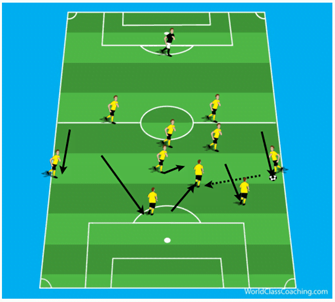
Conclusion
As we have seen, the 4-2-3-1 is a very common playing system among current professional teams. Made up of 4 lines, it provides very good defensive solidity with a vital role for the 2 defensive midfielders. However, poor management of the transition phases can lead to a break between the 6 defensive players and the 4 offensive players.
